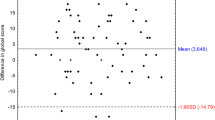Abstract
The objective of this study was to determine the reliability and validity of the Hungarian version of the original Tinnitus Handicap Inventory (THI). In the study design the original THI (THI-US) was translated into Hungarian by three independent investigators. The final Hungarian version (THI-HUN) was constructed on the basis of these Hungarian interpretations and then administered to 72 patients suffering from chronic tinnitus. Construct validity was assessed using short version of Beck’s Depression Inventory (BDI), Perceived Stress Scale (PSS4 version), Visual Analogue Scale (VAS) (loudness, annoyance and pitch of tinnitus), pure tone audiometry and tinnitometry. The 72 participants were 43 women and 29 men. Their mean age was 49.86 years with a mean tinnitus duration of 4.16 years. In the results THI-HUN and its subscales showed good internal consistency reliabilities (α = 0.95–0.74), with significant correlation between THI-HUN total score and subscales and the BDI, PSS4 and VAS annoyance. There was a high or moderate correlation between THI-HUN total score and VAS loudness, tinnitus duration, hearing loss and subjective perception of tinnitus loudness. The VAS pitch of tinnitus, the subjective perception of tinnitus pitch, age, gender and level of education did not show any correlation with THI-HUN total score. The test–retest reliability was high (r = 0.97). We conclude that a valid and reliable THI-HUN questionnaire was constructed.
Similar content being viewed by others
References
Henry JA, Dennis KC, Schechter MA (2005) General review of tinnitus: prevalence, mechanisms, effects and management. J Speech Lang Hear Res 48:1204–1235
Holgers KM, Barrenas ML, Svedlung J, Zöger S (2003) Clinical evaluation of tinnitus: a review. Audiological Medicine 2:101–106
Hoffman HJ, Reed GW (2004) Epidemiology of tinnitus. In: Snow JB Jr (ed) Tinnitus: theory and management. BC Decker, Lewiston, pp 16–41
Newman CW, Jacobson GP, Spitzer JB (1996) Development of the Tinnitus Handicap Inventory. Arch Otolaryngol Head Neck Surg 122:143–148
Zachariae R, Mirz F, Johansen LV, Andersen SE, Bjerring P et al (2000) Reliability and validity of a Danish adaptation of the Tinnitus Handicap Inventory. Scand Audiol 29:37–43
Baguley D, Norman M (2001) Tinnitus Handicap Inventory. J Am Acad Audiol 12:379–380
Kim JH, Lee SY, Kim CH, Lim SL, Shin JN et al (2002) Reliability and validity of a Korean adaptation of the Tinnitus Handicap Inventory. Korean J Otolaryngol-Head Neck Surg 45:328–334
Schmidt LP, Teixeira VN, Dall’Igna C, Dallagnol D, Smith MM (2006) Brazilian Portuguese language version of the “Tinnitus Handicap Inventory”: validity and reproducibility. Braz J Otorhinol 72:808–810
Aksoy S, Firat Y, Alpar R (2007) The Tinnitus Handicap Inventory: a study of validity and reliability. Int Tinnitus J 13:94–98
Monzani D, Genovese E, Marrara A, Gherpelli C, Pingani L et al (2008) Validity of the Italian adaptation of the Tinnitus Handicap Inventory: focus on quality of life and psychological distress in tinnitus-sufferers. Acta Otorhinolaryngol Ital 28:126–134
Kam AC, Cheung AP, Chan PY, Leung EK, Wong TK et al (2009) Psychometric properties of the Chinese (Cantonese) Tinnitus Handicap Inventory. Clin Otolaryngol 34:309–315
Lim JJ, Lu PK, Koh DS, Eng SP (2010) Impact of tinnitus as measured by the Tinnitus Handicap Inventory among tinnitus sufferers in Singapore. Singapore Med J 51:551–557
Ghulyan-Bedikian V, Paolino M, Giorgetti-D’Esclercs F, Paolino F (2010) Psychometric properties of a French adaptation of the Tinnitus Handicap Inventory. Encephale 36:390–396
Mahmoudian S, Shahmiri E, Rouzbahani M, Jafari Z, Keyhani MR et al (2011) Persian language version of the “Tinnitus Handicap Inventory”: translation, standardization, validity and reliability. Int Tinnitus J 16:93–103
Oron Y, Shushan S, Kreitler S, Roth YA (2011) Hebrew adaptation of the tinnitus handicap inventory. Int J Aud 50:426–430
Zhaoli M, Yun Z, Shixi L, Kai W, Xiudan K et al (2012) Reliability and validity of the Chinese (Mandarin) Tinnitus Handicap Inventory. Clin Exp Otorhinolaryngol 5:10–16
Zöger S, Svedlund J, Holgers KM (2006) Relationship between tinnitus severity and psychiatric disorders. Psychosomatics 47:282–288
Cohen S, Kamarck T, Mermelstein R (1983) A global measure of perceived stress. J Health Soc Behav 24:385–396
Cohen S, Williamson GM (1988) Perceived stress in a probability sample of the United States. In: Spacapan S, Oskamp S (eds) The social psychology of health. Sage, Newbury Park, pp 31–67
Stauder A, Konkoly TB (2006) Characteristics of the Hungarian version of the Perceived Stress Scale (PSS). Mentálhigiéné és Pszichoszomatika 7:203–216
Beck AT, Ward CH, Mendelson M, Mock J, Erbaugh J (1961) An inventory for measuring depression. Arch Gen Psychiatry 4:561–571
Beck AT, Beck RW (1972) Screening depressed patients in family practice: a rapid technique. Postgrad Med 52:81–85
Beck AT, Guth D, Steer RA, Ball R (1997) Screening for major depression disorders in medical inpatients the Beck Depression Inventory for primary care. Behav Res Ther 35:785–791
Rózsa S, Szádóczky E, Füredi J (2001) Experiences with the shortened version of the Beck Depression Scale in Hungary. Psychiatria Hungarica 16:379–394
Prestes R, Gil D (2009) Impact of tinnitus on quality of life, loudness and pitch match, and high-frequency audiometry. Int Tinnitus J 15:134–138
Figueiredo RR, Azevedo AA, Oliveira Pde M (2009) Correlation analysis of the visual-analogue scale and the Tinnitus Handicap Inventory in tinnitus patients. Braz J Otorhinolaryngol 75:76–79
Kuk F, Tyler RS, Russel D, Jordan H (1990) The psychometric properties of a tinnitus handicap questionnaire. Ear Hear 11:434–442
Crocetti A, Forti S, Ambrosetti U, Bo LD (2009) Questionnaires to evaluate anxiety and depressive levels in tinnitus patients. Otolaryngol Head Neck Surg 140:403–405
Conflict of interest
The authors declare that they have no conflict of interest.
Author information
Authors and Affiliations
Corresponding author
Appendix
Appendix
The THI-HUN is available on the following website: http://semmelweis.hu/fulorrgegeszet/kutatasi-teruletek/tinnitus-handicap-inventory-kerdoiv.
Rights and permissions
About this article
Cite this article
Bencsik, B., Tamás, L., Trimmel, K. et al. Hungarian adaptation of the Tinnitus Handicap Inventory: reliability and validity. Eur Arch Otorhinolaryngol 272, 2243–2248 (2015). https://doi.org/10.1007/s00405-014-3138-8
Received:
Accepted:
Published:
Issue Date:
DOI: https://doi.org/10.1007/s00405-014-3138-8




